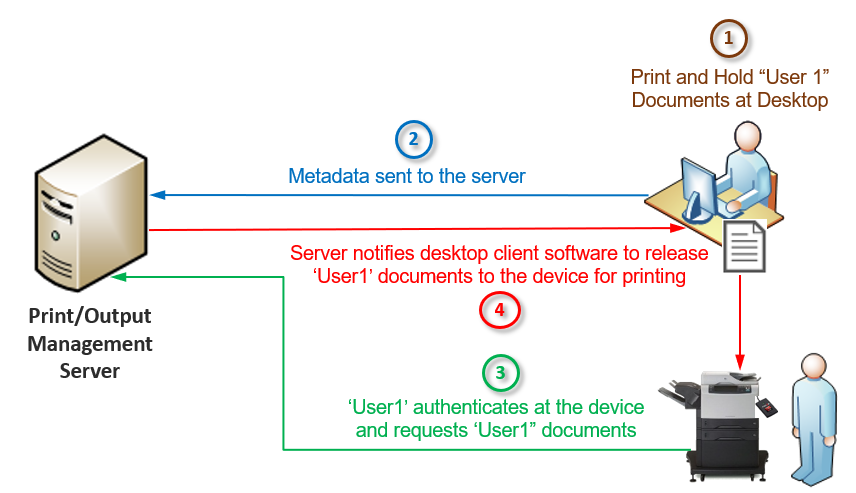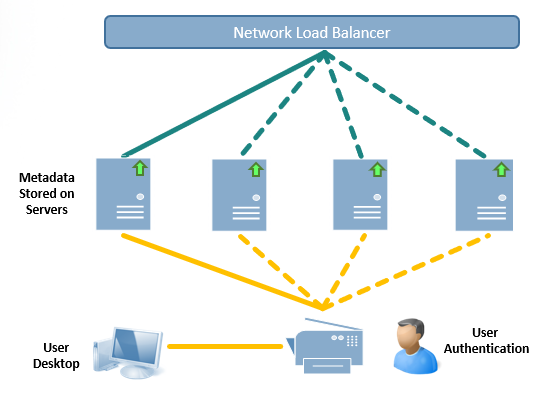High Availability (HA) for Enterprise Pull Printing – Part 2
This is the second part of a two-part blog series about high availability (HA) configurations for enterprise pull printing. If you missed part 1, I recommend that you read it here before continuing with this article.
Many print/output management vendors, including LRS, support a hybrid print architecture for large enterprise environments. In this configuration, a centralized server supports both server-based (spooled) printing and “Direct IP” printing to satisfy the diverse requirements of business applications and users across many locations a global enterprise. Such a solution provides many business and operational benefits, including the elimination of Windows print servers.
Pull printing is an important capability of a hybrid print architecture. Part 1 of this blog focused on high availability for server-based pull printing, where print jobs reside on a server (spool) before being released for printing after the user authenticates at the destination print device.
Now I want to focus on Direct IP pull printing, which I will refer to as “direct secure release” since this terminology is more familiar to LRS customers. With direct secure release, the print jobs remain on the user’s desktop until released by the user at the target print device. A centralized print/output management server is still involved in the authentication and printing process, but it only requires metadata about the print jobs and not the data itself. The following diagram depicts the various components and logic flow of a direct secure release solution:

Now let’s explore a high availability (HA) configuration to support direct secure release. It may not surprise anyone that the configuration options are the same as server-based pull printing. You have the choice of using traditional active-passive server clustering (e.g., Windows server cluster) or running multiple active-active or active-passive servers behind a load balancer.
Based on market experiences over the past couple of years, there is a growing preference toward the use of load balancers and multiple active servers to achieve horizontal scalability. The load balancer distributes the incoming workload across the servers, and it can dynamically switch traffic away from troubled or failed servers. Consider the following diagram of a typical HA configuration:

Since only metadata is sent to print/output management servers in the HA group, no print jobs are lost if a server in the group fails. But, is the metadata lost? This is an important question because without the correct metadata, print jobs held on the desktop will never be released to a print device.
Although I cannot speak for all competitive solutions in the market, I can explain how LRS solves this problem for its direct secure release solution. The LRS solution dynamically replicates each active server’s “state” across the other servers in the HA group, including metadata. This metadata is not limited solely to information about the print jobs held on users’ desktops, but includes all metadata related to the print/output management system. For example, if an IT administrator defines a new print queue on one server, this new queue definition is automatically replicated on the other servers in the group. See the illustration below:

This HA architecture ensures that users will always be able to retrieve their documents at any supported device in the network. It also greatly simplifies the administrative tasks to maintain and upgrade the direct secure release solution across a diverse enterprise. LRS delivers true horizontal scalability with automated failover, so printing can continue without disruption after the failure of n-1 servers.
Of course, if a user’s desktop fails, the print jobs that are held there will remain held until the desktop is operational again. If your organization has concerns about that scenario, you can always consider server-based pull printing. That is an advantage with having a hybrid print architecture – you can mix and match to meet your unique business requirements!
Without an output management solution that supports a hybrid print architecture, no single vendor can provide centralized management and control across all applications, platforms, print devices, and locations in your enterprise. This includes an important function like pull printing. Keep in mind that some print management vendors only offer a Direct IP solution for pull printing, so make sure you get the “whole enchilada.”
Give LRS a call. We understand the complex print requirements of large enterprise environments, and our solution supports a hybrid print architecture for standard printing and pull printing. We also know a thing or two about high availability configurations, and we can share examples of how other large enterprise customers have addressed their unique requirements. We don’t believe in a “one size fits all” approach, and neither should you.